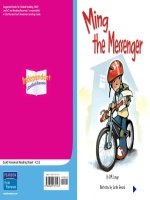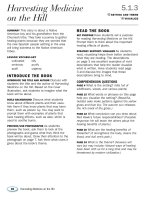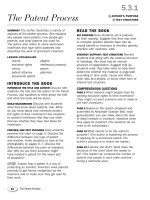- Trang chủ >>
- Mầm non - Tiểu học >>
- Lớp 5
5 5 3 sailing the stars TG
Bạn đang xem bản rút gọn của tài liệu. Xem và tải ngay bản đầy đủ của tài liệu tại đây (122.79 KB, 4 trang )
5.5.3
Sailing the Stars
SUMMARY
This selection gives a brief history
of space travel, beginning with the Cold War
race to launch the first satellite in space and
concluding in today’s era of greater international cooperation. After following milestone
developments such as the inclusion of women
in the United States’ and other countries’
space programs, readers learn what it takes
to be an astronaut, from science training to
swimming tests.
LESSON VOCABULARY
accomplishments
gravity
role
focus
monitors
specific
INTRODUCE THE BOOK
INTRODUCE THE TITLE AND AUTHOR
Discuss with
students the title and author of Sailing the
Stars. Draw students’ attention to the Science
content triangle. Ask: Does the title Sailing the
Stars have a scientific ring to it? What images
does the title create? Why do you think the
author chose a poetic title for a scientific
article?
BUILD BACKGROUND
Invite students to discuss
what they know about space travel, based on
books, movies, museums, or other sources.
Do you think the images you have of space
travel are realistic? Encourage students to
recall anything they’ve heard about Sputnik,
Neil Armstrong, Sally Ride, or other people
and events associated with space travel.
PREVIEW/USE TEXT FEATURES
Have students
take a few minutes to go over the Table of
Contents, photos, captions, and boxes on
pages 6 and 13 before reading the text. Ask:
What do the photos add? Would illustrations
have worked as well? Do photos seem more
scientific? Why or why not? Can you guess
from the text features whether the article is
organized chronologically or geographically?
100
AUTHOR’S PURPOSE
MONITOR AND FIX UP
READ THE BOOK
SET PURPOSE
Guide students to set their own
purposes for reading the selection. Students’
interest in space travel, astronomy, or other
branches of science, or the history of pioneering women in science should guide this
purpose. Invite them to use the pictures to
come up with questions they would like to
have answered, such as What might it feel like
to walk in space? How heavy are those suits?
Why do astronauts learn to scuba dive? Could I
become an astronaut?
STRATEGY SUPPORT: MONITOR AND FIX UP
Encourage students to jot down any points
that confuse them as they read. Suggest
that they reread, read the surrounding text to
understand context, or seek clarification from
an outside source, such as a dictionary, the
Internet, or a teacher.
COMPREHENSION QUESTIONS
PAGE 3
What can you tell about the author’s
purpose from the chapter titles? (Possible
response: She wants to inform readers about
space travel.)
PAGE 4
Notice that the definition for orbit is
between commas in the sentence A satellite
is something that orbits, or travels around, a
larger body in space. Write a similarly constructed sentence that uses one of the
vocabulary words. (Responses will vary.)
PAGE 11
What is one reason there were no
women test pilots in the 1950s and 1960s?
(Possible response: Women were barred from
the necessary training.)
PAGE 17
What does the survival training tell
you about the work of astronauts? (Possible
response: It is very dangerous.)
Sailing the Stars
16917_LRD_TG_100-101 100
11/17/05 9:09:40 AM
REVISIT THE BOOK
READER RESPONSE
1. Possible response: To show that the U.S.
and the U.S.S.R. were at odds. Their rivalry
fueled the space program.
2. Responses will vary but should include the
main points of the chapter.
3. screens; watches. Possible response:
Please focus on your homework. The
telescope was out of focus.
4. Responses will vary.
EXTEND UNDERSTANDING
Invite students to
create their own graphic device that relates
information from the article, such as a time
line or a chart comparing the history of
American and Russian space travel.
RESPONSE OPTIONS
WRITING
Suggest that students imagine being
the only woman or the only African American in
a class of NASA astronauts. Ask them to write
a paragraph or two describing their experience
and feelings as pioneers in their field.
SOCIAL STUDIES
CONNECTION
Have students research
a pioneer in a field of
their choosing, whether in science
or the arts and humanities. Remind
them that a pioneer is a person who breaks
new ground. Ask them to share their
research, including such details as what
motivated or inspired the person.
Skill Work
TEACH/REVIEW VOCABULARY
Divide students into groups, give a time limit,
and ask the groups to come up with as many
synonyms as possible for each word. If synonyms prove difficult (such as for gravity),
allow students to use phrases.
Remind English language learners
that words are often made of parts, such
as astro and naut in astronaut. Encourage
them to break the vocabulary words into
their parts, using a dictionary if necessary.
TARGET SKILL AND STRATEGY
AUTHOR’S PURPOSE Tell students that an
author’s purpose is the reason or reasons
that she or he has for writing (such as to
persuade, inform, entertain, or express).
Remind students they must often infer the
author’s purpose, based on text clues.
Sailing the Stars, for example, contains
dates, historic photos, and facts about the
history of space travel. Ask: What does this
suggest about the author’s purpose? If the
author’s purpose in this selection were to
entertain, would the selection be different?
MONITOR AND FIX UP Tell students that
monitoring and fixing up is the process by
which they keep track of their own comprehension. They should notice if the text stops
making sense and ask such questions as
What does this mean? Why did the author
include this? Answering such questions
will also help students identify the author’s
purpose.
ADDITIONAL SKILL INSTRUCTION
SEQUENCE Remind students that sequence
is the order of events in a story or article.
Point out that Sailing the Stars includes many
dates. Help students see that the book is
organized chronologically. Ask: What does
ordering these events in this way tell you
about the author’s purpose? Suggest that
students create their own time line of the
events discussed in the article.
Sailing the Stars
16917_LRD_TG_100-101 101
101
11/17/05 9:09:41 AM
Name
Sailing the Stars
Author’s Purpose
• An author’s purpose is the reason or reasons an author has for writing.
• Four common reasons are: to persuade, to inform, to entertain, to express ideas.
Directions Read the paragraphs below. Then answer the questions on the lines below.
I
n 2003, China joined an exclusive club when 38-year-old former fighter pilot Yang Liwei
orbited Earth 14 times. China is now only the third country in history to have launched a
person into space.
Space exploration is now a worldwide effort. Together we can learn new and exciting
things. And, if you really try, perhaps you will be one of the people who sail the stars!
1. What would you say is the author’s main purpose in writing the first paragraph?
2. Explain your answer.
3. What purpose might the author have in the second paragraph?
5. How do you think the author’s two purposes might work together?
© Pearson Education 5
4. Explain your answer.
102
16917_LRD_TG_102-103 1
11/17/05 9:10:13 AM
Sailing the Stars
Name
Vocabulary
Directions Choose the word from the box that best matches each definition. Write the word on the line.
Check the Words You Know
accomplishments
gravity
role
focus
monitors
specific
1. exact, definite
2. the force that pulls things towards Earth
3. computer screens that display data
4. to concentrate; an area of study or observation
5. a purpose or use of someone or something
6. successes, achievements; skills
© Pearson Education 5
Directions Write two sentences on the lines below about Sailing the Stars. Use as many vocabulary
words as you can.
103
16917_LRD_TG_102-103 2
11/17/05 9:10:15 AM









